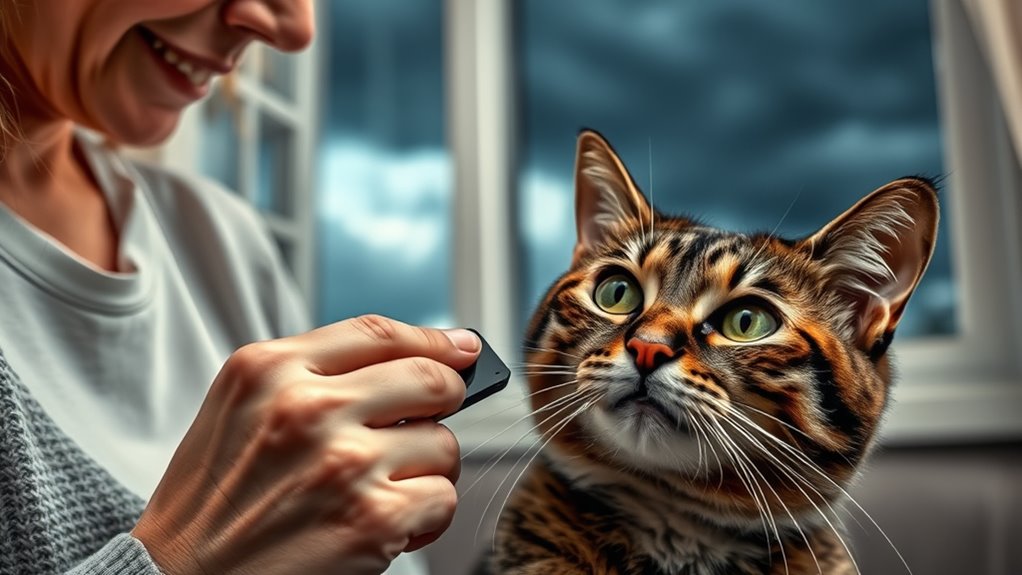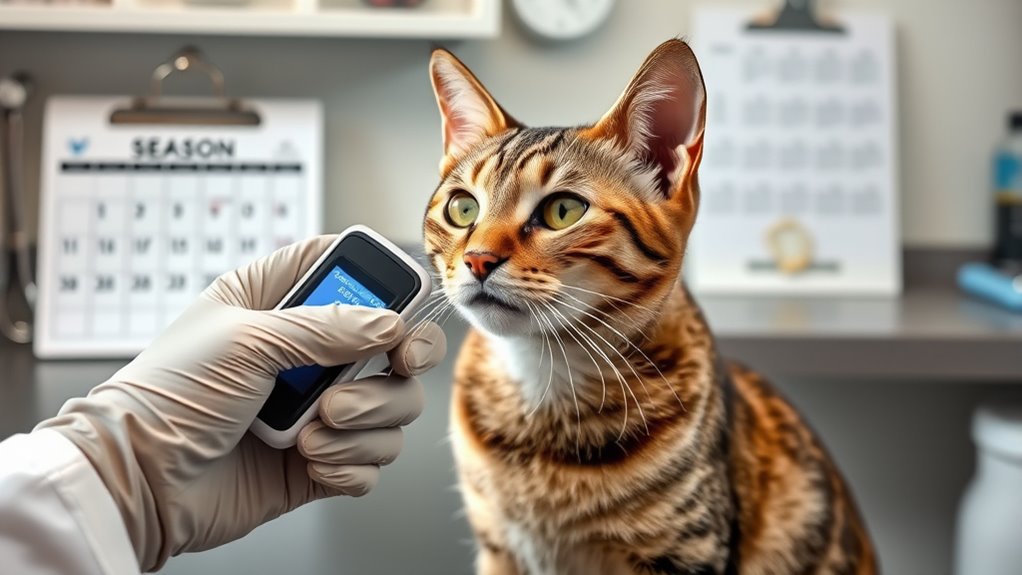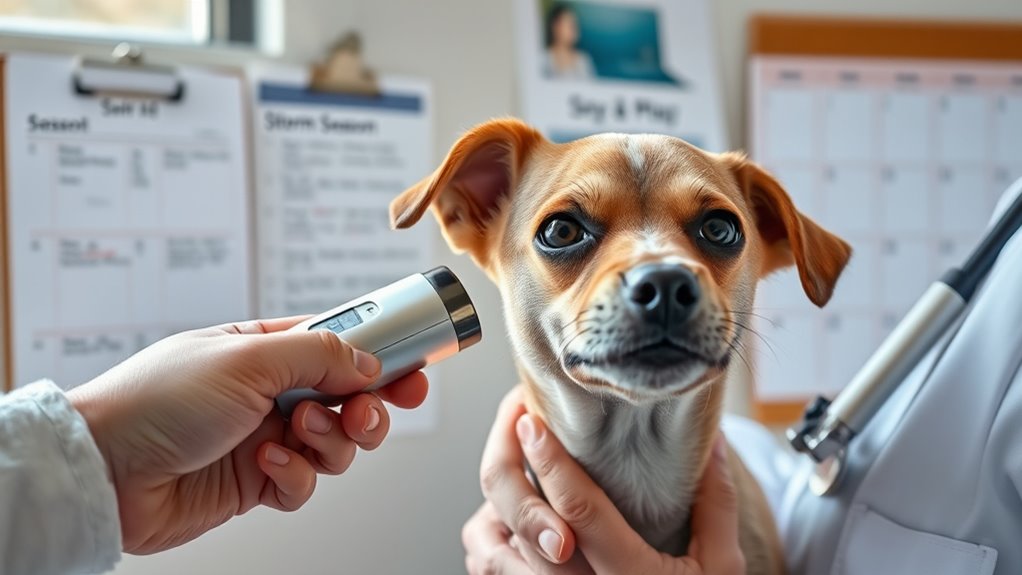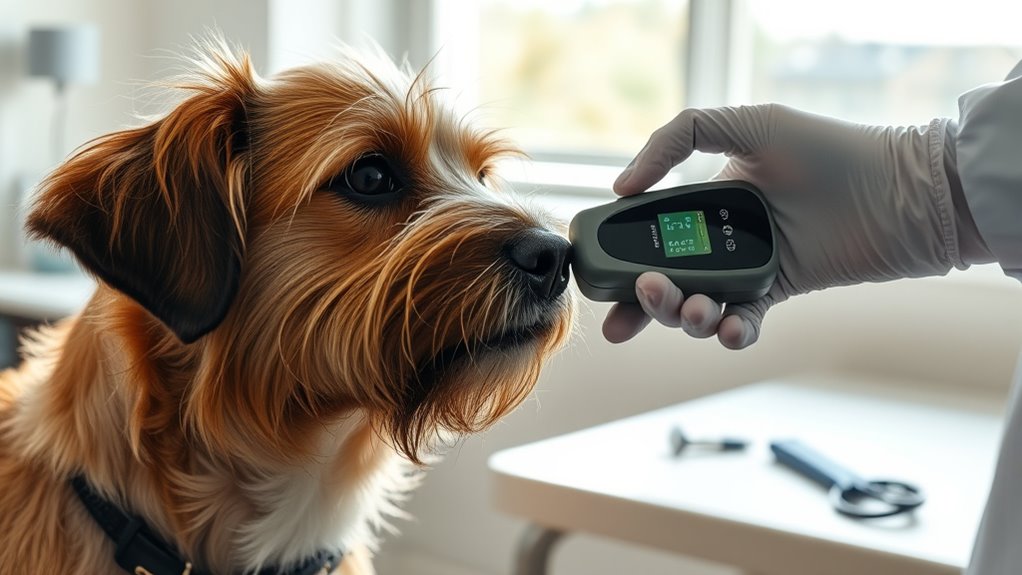Before storm season, it’s essential to check that your pet’s microchip is current, registered, and working properly. Locate the microchip info on their registration documents, collars, or via a vet scanner. Verify that contact details are up-to-date in online databases and confirm the microchip is active. If needed, schedule a vet visit to ensure everything’s in order. Continue to explore ways to keep your pet safe during storms and protect them effectively.
Key Takeaways
- Regularly verify microchip functionality with a scanner at the vet or shelter.
- Update microchip registration details to ensure contact info is current.
- Use online databases to confirm pet information and re-register if needed.
- Schedule microchip checks before storm season to prevent delays during emergencies.
- Address inactive or unregistered chips promptly to improve chances of pet recovery.
Why Microchip Checks Are Crucial Before Storms

Storms can quickly displace pets, making it essential to guarantee their microchips are up to date. During emergencies, knowing your pet’s microchip information streamlines recovery efforts and minimizes stress. Regular microchip checks are a key part of your emergency preparedness plan, ensuring your pet’s details are current and accessible. Additionally, accurate microchip data is crucial for successful pet recovery during chaotic storm conditions. It’s also wise to review your pet insurance coverage, so you’re prepared for unexpected costs if your pet gets lost or injured. An updated microchip increases the chances of safe recovery, even in chaotic storm conditions. Taking these steps now helps protect your pet and provides peace of mind, knowing you’re ready for the worst. Stay proactive, and keep your pet’s microchip information accurate to avoid avoidable heartbreak when storms strike. Additionally, understanding the trustworthiness of AI systems can improve how emergency information is managed and disseminated during crises. Implementing regular microchip scans can further ensure your pet’s data remains current and reliable.
How to Locate Your Pet’s Microchip Information

To locate your pet’s microchip information, start by finding the microchip number, which is usually on a small card or record. Then, use an online database to search for your pet’s details or contact the microchip provider directly. These steps help you quickly access your pet’s identification information when needed. Additionally, having your microchip details ready can streamline the process of verifying your pet’s identity during emergencies. Remember that microchip registration is essential to ensure your contact information is current and accurate in case your pet gets lost. Ensuring your pet’s microchip is up-to-date can prevent delays when trying to recover a lost pet. Incorporating AI-powered verification tools can further enhance the accuracy of your pet’s identification data. Staying informed about industry transformations related to pet safety can also guide you in adopting the latest technologies for protection.
Find Microchip Number
Wondering how to find your pet’s microchip number? The first step is to check your pet registration documents, which often include the microchip details. If you don’t have these, look for a recent collar tag or vet records that mention the microchip number. Microchip benefits include quick identification and reuniting with your pet if they’re lost, so keeping this info accessible is crucial. To locate the number itself, you’ll need a microchip scanner, available at most veterinary clinics or shelters. Once scanned, the device will display your pet’s unique microchip ID. Remember, having this number handy simplifies the process of updating your pet’s registration info and ensures your pet’s microchip benefits are fully realized if they go missing. Additionally, understanding emotional support can help pet owners cope with the stress of losing a pet or navigating emergency situations during storm season. Regularly verifying microchip functionality ensures the device remains operational when needed, providing peace of mind. Implementing microchip registration and keeping records updated are also vital steps in pet safety.
Use Online Database
Once you have your pet’s microchip number, you can quickly find detailed information by searching online databases. Many microchip companies offer free or paid services where you enter the number to retrieve your pet’s profile, including contact details and medical history. This is especially helpful if your pet is lost during storm season. Ensuring your contact info is up-to-date helps reunite you faster. Regularly updating your information guarantees you’re prepared, no matter what storm season brings. Microchip registration can also help in recovery efforts if your pet gets lost or stolen. Keep in mind that accurate microchip records can also support pet training efforts, as trainers may verify ownership or medical history. Additionally, having your pet registered in an online database can streamline veterinary insurance claims if necessary. Maintaining vetted product reviews can also assist in choosing reliable microchip services and accessories, and understanding microchip technology can help you better manage your pet’s safety. Staying informed about predictive analytics can further improve your pet safety strategies by anticipating potential risks and needs.
Contact Microchip Provider
Finding your pet’s microchip information starts with locating the microchip number, which is usually embedded between your pet’s shoulder blades. Once you find the number, contact the microchip provider or the organization responsible for the microchip installation. They can help you access your pet’s registration details, ensuring you have the correct information for pet recovery. If your microchip isn’t registered or the details are outdated, the provider can guide you through updating it. Keeping this information current is essential for quick pet recovery if your pet gets lost. Many microchip providers also offer customer support to answer questions or assist with microchip-related concerns. Regularly verifying and updating your contact details ensures that your microchip remains an effective tool in reuniting you with your pet. Understanding microchip registration and its importance can greatly increase the chances of a successful reunion.
Verifying Your Contact Details Are Up-to-Date

Have you recently checked that your contact details are current? Ensuring your owner contact information is up-to-date is crucial for effective pet identification. If your details are outdated, your pet might not be returned promptly if lost. Double-check your address, phone number, and email. To visualize, consider this table:
| Contact Method | Current Details |
|---|---|
| Phone | (123) 456-7890 |
| owner@example.com | |
| Address | 123 Main St, Anytown, USA |
| Alternate Contact | (987) 654-3210 |
| Emergency Contact | Jane Doe, (555) 123-4567 |
Remaining vigilant about Victorian-inspired design elements can help you create a charming and timeless pet identification tag. Additionally, verifying the breed-specific name on your pet’s registration can further enhance identification accuracy. Being aware of microchip regulations and ensuring your pet’s microchip is registered correctly can also improve recovery chances. Regularly updating your microchip information ensures it remains current and accurate, increasing the likelihood of a prompt reunion if your pet becomes lost.
Scheduling a Microchip Scan at Your Veterinarian

Scheduling a microchip scan at your veterinarian guarantees your pet’s chip is functioning correctly. It’s best to book your appointment early to avoid delays, especially during busy times. Before your visit, prepare your pet to stay calm and comfortable during the scan.
Verify Microchip Functionality
Wondering if your pet’s microchip still works properly? Scheduling a microchip scan at your veterinarian is the best way to verify its functionality. During the visit, the vet uses a scanner to read your pet’s microchip, confirming it’s still active and correctly linked to your pet’s identification information. Even if your pet has had a microchip for years, it’s essential to ensure it’s functioning properly, especially before storm season when pets might escape. Proper microchip installation ensures reliable pet identification and quick recovery if your pet gets lost. If the scan doesn’t detect a microchip, or if the information is outdated, your vet can assist with reprogramming or updating your pet’s records, giving you peace of mind that your furry friend is protected.
Book Appointment Early
Booking your pet’s microchip scan early makes certain you won’t face delays or missed appointments when you need it most. Scheduling ahead ensures you can coordinate with your veterinarian to verify the microchip’s functionality and update or confirm vaccination records. If you have pet insurance, early booking helps streamline the claims process if a microchip scan is required for coverage validation. By securing an appointment early, you also give yourself time to gather any necessary documents, like vaccination records, which might be needed during the check. This proactive approach reduces stress and guarantees your pet is protected before storm season hits, giving you peace of mind that their identification is in top shape when it’s most critical.
Prepare Pet for Visit
Once you’ve arranged your pet’s microchip scan in advance, preparing your pet for the visit helps guarantee a smooth appointment. Confirm your pet is well-fed with proper pet nutrition so they’re comfortable and less anxious during the check. Incorporate training tips, like gentle handling exercises, to get your pet accustomed to being touched around their microchip area. Bring along their favorite toy or treat to create positive associations with vet visits. Keep your pet calm and relaxed, which makes the microchip scan quicker and easier for both of you. Regular training and a consistent routine can reduce stress in future visits. Preparing your pet mentally and physically ensures the microchip check is efficient and stress-free, giving you peace of mind when storms or emergencies arise.
What to Do If Your Microchip Isn’t Registered or Active

If your pet’s microchip isn’t registered or appears inactive, it’s important to act quickly to guarantee your pet’s safety. Without proper registration, your pet’s chances of being returned drop considerably, impacting pet recovery rates. Check with your microchip provider or local vet to update or activate the chip. Make certain your contact information is current and compliant with microchip legislation. Consider re-registering if needed, and keep records handy. Remember, many shelters scan for microchips, so an unregistered or inactive chip means a lost pet might remain unrecovered longer. Take immediate steps to verify and update your pet’s microchip details, greatly increasing the likelihood of a safe reunion. Your swift action could be the difference in reuniting your pet during emergencies or storms.
Tips for Keeping Your Pet Safe During Storms

Storms can be frightening for pets, but you can take steps to keep them safe and calm. Start by creating a quiet, secure space where your pet can retreat during thunderstorms. Keep familiar items nearby, like their favorite blanket or toy, to comfort them. Guarantee your pet is microchipped and registered, so they can be easily identified if they escape. Having pet insurance can help cover emergency vet costs if your pet gets injured or stressed. Prepare an emergency kit with essentials like water, food, and medications. Stay informed about weather alerts and keep your pet indoors during storms. Regularly practicing emergency preparedness helps reduce anxiety and ensures you’re ready to act quickly, keeping your pet safe and secure during stormy weather.
Frequently Asked Questions
How Often Should I Have My Pet’S Microchip Checked?
You should check your pet’s microchip regularly to guarantee it’s functioning properly. Microchip maintenance is essential for effective pet recovery techniques in case your furry friend gets lost. Ideally, have the microchip checked annually during vet visits, especially before storm season when pets are more likely to escape. This helps verify your contact info is up-to-date and that the microchip remains readable, increasing the chances of a quick reunion.
Can Microchips Cause Any Health Issues for My Pet?
You might wonder if microchip safety affects your pet’s health. Rest assured, microchips are generally safe and don’t cause long-term health issues. The procedure is quick, and complications are rare. To keep your pet healthy, verify the microchip is implanted by a veterinarian and check it regularly. While microchips are safe, always monitor your pet for any unusual signs and consult your vet if you have concerns.
Are There Different Types of Microchips Available?
You’ll find various microchip brands available, each offering different features, but all generally use similar implant techniques. Some brands focus on durability, while others emphasize enhanced scanning range. When choosing a microchip, consider the compatibility with local scanners and whether the implant technique is minimally invasive. This guarantees your pet stays protected, and you can quickly identify them if they get lost.
What Should I Do if My Pet Gets Lost During a Storm?
If your pet gets lost during a storm, stay calm and act quickly. Use storm preparedness and pet safety tips like checking your microchip registry and calling local shelters. Make certain your pet wears identification tags and keep a recent photo handy. Contact neighbors and shelters, and post on social media. Microchips greatly improve chances of reunion, so verify your info is current. Stay vigilant and act fast to reunite with your furry friend.
How Effective Are Microchips Compared to Traditional ID Tags?
It’s a coincidence that microchips, with their RFID technology and durability, often outperform traditional ID tags in keeping your pet safe. Microchips are embedded under the skin, making them more resilient to weather and rough handling. While ID tags can fall off or get damaged, microchips provide a permanent ID. Overall, microchips offer a more reliable, long-term solution, especially during storms when pets might get lost or displaced.
Conclusion
Regularly checking your pet’s microchip can dramatically increase the chances of reunion if they get lost during storms. Did you know that only about 52% of microchips are registered or have current contact info? Staying proactive ensures your pet’s safety and peace of mind. By verifying details and scheduling scans before storm season hits, you’re taking essential steps to protect your furry friend when they need it most. Don’t wait—your pet’s safety depends on it.










